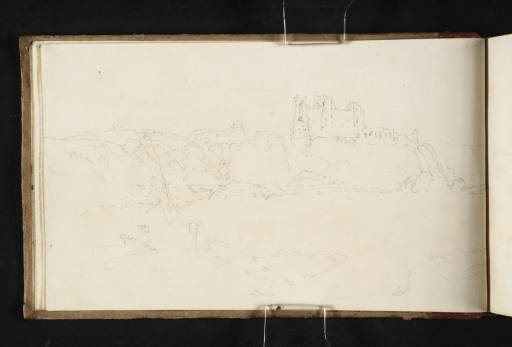Joseph Mallord William Turner Tantallon Castle and Bass Rock 1818
Image 1 of 2
Joseph Mallord William Turner,
Tantallon Castle and Bass Rock
1818
Joseph Mallord William Turner 1775–1851
Folio 5 Verso:
Tantallon Castle and Bass Rock 1818
D13593
Turner Bequest CLXVII 5a
Turner Bequest CLXVII 5a
Pencil on white wove paper, 112 x 186 mm
Inscribed in pencil by Turner ‘grey | [?]glum’ bottom left
Inscribed in pencil by Turner ‘grey | [?]glum’ bottom left
Accepted by the nation as part of the Turner Bequest 1856
References
1909
A.J. Finberg, A Complete Inventory of the Drawings of the Turner Bequest, London 1909, vol.I, p.484, CLXVII 5a, as ‘Tantallon Castle and Bass Rock.’.
1979
Andrew Wilton, J.M.W. Turner: His Life and Work, Fribourg 1979, p.426 under no.1067.
1983
Timothy Clifford, J.M.W. Turner: Aquarelles de la City Art Gallery, Manchester, exhibition catalogue, Musée des Beaux-Arts, Bordeaux 1983, p.38 under cat.10b.
1984
Timothy Clifford and Torsten Gunnarsson, J.M.W. Turner: Akvareller Målningar Grafik, exhibition catalogue, Nationalmuseum, Stockholm 1984, p.48 cat.22.
1985
Timothy Clifford and Shuji Yashiro, Turner at Manchester, exhibition catalogue, Odakyu Grand Gallery, Tokyo 1985, p.[48] cat.17.
1997
Charles Nugent and Melva Croal, Turner Watercolors from Manchester, exhibition catalogue, Memphis Brooks Museum of Art, Memphis 1997, p.64 under cat.36.
1999
Katrina Thomson, Turner and Sir Walter Scott: The Provincial Antiquities and Picturesque Scenery of Scotland, exhibition catalogue, National Gallery of Scotland, Edinburgh 1999, p.26 fig.6, cat.10.
Drawn over two pages is a view of Tantallon Castle on the East Lothian coast, and the island of Bass Rock (continued on folio 6; D13594; CLXVII 6) which lies in the Firth of Forth about a mile from the shore. The composition is similar to the sketch on folio 4 verso (D13591; CLXVII 4a), though it is in a more highly finished state and the view is more expansive. Standing on a headland to the east (shown in the foreground at the bottom of folio 6) we look west towards Tantallon, and north towards the Bass. The castle stands on a headland, protected by the sheer cliff and sea on three sides, and particular attention has been paid in the sketch to the appearance of the cliffs: steep and grass-topped with fissures and gullies leading down to a narrow strip of rocks and sand beneath.
This double-page sketch has generally been regarded, since Finberg’s note – “See Engraving in Part VI. Scott’s “Provincial Antiquities” –1 as the basis for Turner’s Tantallon Castle, 1821 (Manchester City Galleries)2 design for Scott’s Provincial Antiquities. Indeed the castle itself was predominantly based on the present sketch, and the Bass Rock, although brought much closer to the castle, and partially obscured by waves, is again close in appearance to the drawing. However, the viewpoint of the final watercolour is from lower down, almost at sea level, so that we look up at the castle with the cliff edge to the left.3
The vantage point is therefore directly beneath the spot from which the current sketch is taken, and Turner must have scrambled down the rocks from here to sketch it. The sketch across folios 8 verso and 9 (D13598–D13599; CLXVII 8a–8b) was taken from this point and it was this sketch upon which Turner based his composition. Andrew Wilton has also noted the similarity of the composition to a sketch from the Smaller Fonthill sketchbook of 1801 (Tantallon Castle, pencil on paper, Princeton University Art Museum, USA), now detached.4 The vantage point was therefore in 1818 a familiar one.
Turner’s various sketches of Tantallon Castle and the different views he experimented with in this sketchbook concentrate on the relationship of the castle to the sea which surrounded it on three sides. He seems to have been aware of Scott’s romantic evocation of the castle in his poem, Marmion, from as early as 1811,5 and was here looking for a view to match Scott’s description of the castle:
In Turner’s Provincial Antiquities design he succeeded in aligning his vision with Scott’s description of the castle, ‘overhanging the billows of a wide and often troubled ocean, an imposing effect on the imagination’.7
Thomas Ardill
February 2008
How to cite
Thomas Ardill, ‘Tantallon Castle and Bass Rock 1818 by Joseph Mallord William Turner’, catalogue entry, February 2008, in David Blayney Brown (ed.), J.M.W. Turner: Sketchbooks, Drawings and Watercolours, Tate Research Publication, December 2012, https://www


